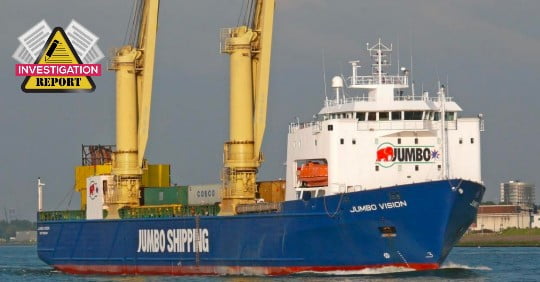Federal Bureau of Maritime Casualty Investigation released a report focusing on a cargo-related accident onboard the JUMBO VISION, while at berth in the port of Rostock on 31 January 2020.
The case
On 30 January 2020, the heavy-lift vessel JUMBO VISION was at berth in the overseas port of Rostock. During the course of this and the following day, two Liebherr LHM 550 mobile harbour cranes were loaded onto the ship’s hatch covers, one after the other.
The ship’s own cargo-handling gear was used in tandem operation to achieve this. By about 20451 on 31 January, the stabilising pontoons2 had been hauled in. The aft crane’s wheelsets were swivelled in a transverse direction. For various reasons, this crane had to be moved a short distance towards the seaward side. At first it was accidentally started up in the wrong direction, before the mistake was noticed and it was moved in the required direction.
After the crane had been moved by a few centimetres, it had to be stopped because of an obstacle. Despite the use of various operating commands (stop, reverse, etc.), it was not possible to bring it to a standstill. Without any apparent response, the crane rolled off the hatch and subsequently fell into the harbour basin. Due to the heavy list that this caused, the forward crane also slid into the water immediately afterwards.
The JUMBO VISION sustained minor damage, mainly to the fittings and railing of the water-side deck passageway. The two LHM 550s were salvaged about a month later. Up until then, the harbour basin concerned was closed, fully at first and later partially. There was minor water pollution due to escaping operating fluids.
The BSU’s investigators were presented with various possible hypotheses as to why the crane had apparently not responded to the operating commands. These hypotheses were worked through one after the other and largely disproved. Ultimately, a combination of several factors proved responsible for the accident.
An expert stability report demonstrated that the starting and braking movements triggered an amplifying roll oscillation of the entire ship. The movement of the crane to the seaward side coincided with a rolling motion in the same direction.
An expert report on the hydraulic drive of the LHM 550 revealed that at least one of the driving wheelsets of the crane that fell first began to slip and spin, due to which the crane was unable to transmit its drive power to the surface underneath it.
A communication deficit concerning all involved parties further contributed to the accident.
Lessons learned:
Based on the findings of the investigation and their analysis, the BSU has reached the following conclusions in this case:
- The JUMBO VISION’s stability was insufficient on the night of the accident. Although it would have been sufficient for the sea transport of the fully secured cranes (static effects), this was not the case for moving and braking them on deck with topped-up jibs (dynamic effects). This is not contradicted by the fact that the crew could not have known this, given the means at their disposal.
- The stabilising pontoons had already been hauled in at the time of the accident. However, the ship’s stability margin would have been sufficient to prevent the accident had they been deployed. Yet after completion of the cargo securing operations it would no longer have been possible to retrieve them.
- The starting and braking moments of the crane’s movement triggered an amplifying roll oscillation. Due to the low stability, this was greater in terms of amplitude and roll period than it presumably would have been on previous voyages with similar deck cargo situations. A ”tender” ship is altogether more susceptible to rolling movements of every kind, and thus also to the triggering of amplifying roll oscillations.
- Both the movement sequence of crane 2 at the very beginning and later its steady movement towards the outer edge amplified this roll oscillation unfavourably.
- The long roll period also had an accident-promoting effect (no ”rollback moment” at the right time). Consequently, shortly after crane 2 was started up, an inclination was reached that exceeded the manufacturer’s limit for moving the crane.
- Due to the low friction between the steel plates and the deck, at least one driven wheelset began to slip. This wheelset, which subsequently spun faster and faster, additionally consumed crane 2’s remaining hydraulic driving power.
- The critical transverse surface inclination value of 1.15° when moving the LHM 550 was apparently unknown on board. The BSU attributes this to a communication deficit between the parties involved.
- The ship did not communicate the planned procedure after loading the cranes (first retrieving the stabilising pontoons, then moving the cranes on deck) to Jumbo Shipping’s planning department.
- The process of setting down the cranes’ jibs and securing the ship’s own cargohandling gear, as well as the procedure for retrieving the stabilising pontoons were left to the ship.
- The dynamic effects of starting and braking the cranes on deck were not considered in the preliminary planning. It is reasonable to assume that the parties involved in the preliminary planning were not familiar with the effects in question.
- Although the accident could theoretically have been prevented if precise stability management had been pursued, ships are not equipped with electronic precision inclinometers and crews are not familiarised with the required procedures.






























































